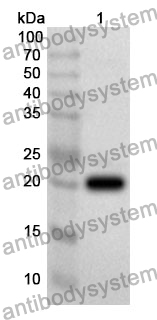Catalog No.
PHD58401
Species reactivity
Human, Mouse, Rat
Host species
Rabbit
Isotype
IgG
Clonality
Polyclonal
Immunogen
E. coli - derived recombinant Human PTPRZ1 (Leu32-Glu189).
Tested applications
ELISA: 1:4000-1:8000, IHC: 1:50-1:100, WB: 1:1000-1:4000
Target
Receptor-type tyrosine-protein phosphatase zeta,R-PTP-zeta,R-PTP-zeta-2,PTPRZ1,PTPRZ,PTPRZ2,PTPZ,HTPZP2,Protein-tyrosine phosphatase receptor type Z polypeptide 2,Protein-tyrosine phosphatase receptor type Z polypeptide 1
Purification
Purified by antigen affinity column.
Accession
P23471
Applications
ELISA, IHC, WB
Form
Liquid
Storage buffer
0.01M PBS, pH 7.4, 50% Glycerol, 0.05% Proclin 300.
Stability and Storage
Use a manual defrost freezer and avoid repeated freeze thaw cycles. Store at 2 to 8°C for frequent use. Store at -20 to -80°C for twelve months from the date of receipt.
Pleiotrophin Activates cMet- and mTORC1-Dependent Protein Synthesis through PTPRZ1-The Role of ανβ3 Integrin., PMID:39409168
PTPRZ1-Targeting RNA CAR T Cells Exert Antigen-Specific and Bystander Antitumor Activity in Glioblastoma., PMID:39269445
Challenges in the discovery of tumor-specific alternative splicing-derived cell-surface antigens in glioma., PMID:38493204
Challenges in the discovery of tumor-specific alternative splicing-derived cell-surface antigens in glioma., PMID:37961484
PTN-PTPRZ1 signaling axis blocking mediates tumor microenvironment remodeling for enhanced glioblastoma treatment., PMID:36402232
The landscape of receptor-mediated precision cancer combination therapy via a single-cell perspective., PMID:35338126
Cerebral Organoids Maintain the Expression of Neural Stem Cell-Associated Glycoepitopes and Extracellular Matrix., PMID:35269382
Beta3Gn-T7 Is a Keratan Sulfate β1,3 N-Acetylglucosaminyltransferase in the Adult Brain., PMID:35221933
Human Oligodendrocyte Myelination Potential; Relation to Age and Differentiation., PMID:34952986
Protein tyrosine phosphatase PTPN1 modulates cell growth and associates with poor outcome in human neuroblastoma., PMID:31837707
Distinct Function-Related Molecular Profile of Adult Human A2B5-Positive Pre-Oligodendrocytes Versus Mature Oligodendrocytes., PMID:31058285
GlcNAc6ST3 is a keratan sulfate sulfotransferase for the protein-tyrosine phosphatase PTPRZ in the adult brain., PMID:30867513
Tumour-associated macrophages secrete pleiotrophin to promote PTPRZ1 signalling in glioblastoma stem cells for tumour growth., PMID:28569747
Role of Chondroitin Sulfate (CS) Modification in the Regulation of Protein-tyrosine Phosphatase Receptor Type Z (PTPRZ) Activity: PLEIOTROPHIN-PTPRZ-A SIGNALING IS INVOLVED IN OLIGODENDROCYTE DIFFERENTIATION., PMID:27445335
Pleiotrophin regulates the retention and self-renewal of hematopoietic stem cells in the bone marrow vascular niche., PMID:23084748
Monoclonal antibody Cat-315 detects a glycoform of receptor protein tyrosine phosphatase beta/phosphacan early in CNS development that localizes to extrasynaptic sites prior to synapse formation., PMID:16989954
Targeting of the receptor protein tyrosine phosphatase beta with a monoclonal antibody delays tumor growth in a glioblastoma model., PMID:16489031
Changes in the amounts of chondroitin sulfate proteoglycans in rat brain after neonatal hypoxia-ischemia., PMID:16041802
Growth factor and cytokine regulation of chondroitin sulfate proteoglycans by astrocytes., PMID:15968632
Functional comparison of long and short splice forms of RPTPbeta: implications for glioblastoma treatment., PMID:15831233
Neuronal expression of the chondroitin sulfate proteoglycans receptor-type protein-tyrosine phosphatase beta and phosphacan., PMID:15708477
alpha4beta1- and alpha6beta1-integrins are functional receptors for midkine, a heparin-binding growth factor., PMID:15466886
Expression of phosphacan and neurocan during early development of mouse retinofugal pathway., PMID:15283989
Expression and function of the receptor protein tyrosine phosphatase zeta and its ligand pleiotrophin in human astrocytomas., PMID:14692702
Kainic acid-induced convulsions cause prolonged changes in the chondroitin sulfate proteoglycans neurocan and phosphacan in the limbic structures., PMID:14637091
A role for receptor tyrosine phosphatase zeta in glioma cell migration., PMID:14555979
Heterogeneity of the chondroitin sulfate portion of phosphacan/6B4 proteoglycan regulates its binding affinity for pleiotrophin/heparin binding growth-associated molecule., PMID:12840014
Phosphacan and neurocan are repulsive substrata for adhesion and neurite extension of adult rat dorsal root ganglion neurons in vitro., PMID:12821372
Phosphacan short isoform, a novel non-proteoglycan variant of phosphacan/receptor protein tyrosine phosphatase-beta, interacts with neuronal receptors and promotes neurite outgrowth., PMID:12700241
A chondroitin sulfate proteoglycan PTPzeta /RPTPbeta regulates the morphogenesis of Purkinje cell dendrites in the developing cerebellum., PMID:12684467
Receptor-type protein tyrosine phosphatase zeta as a component of the signaling receptor complex for midkine-dependent survival of embryonic neurons., PMID:12573468
Developmentally regulated expression of brain-specific chondroitin sulfate proteoglycans, neurocan and phosphacan, in the postnatal rat hippocampus., PMID:11702233
Overlapping functions of the cell adhesion molecules Nr-CAM and L1 in cerebellar granule cell development., PMID:11564762
Soluble forms of NCAM and F3 neuronal cell adhesion molecules promote Schwann cell migration: identification of protein tyrosine phosphatases zeta/beta as the putative F3 receptors on Schwann cells., PMID:11520897
Inhibitory effects of neurocan and phosphacan on neurite outgrowth from retinal ganglion cells in culture., PMID:11431463
Expression of brain specific chondroitin sulfate proteoglycans, neurocan and phosphacan, in the developing and adult hippocampus of Ihara's epileptic rats., PMID:11292447
Inhibitory proteoglycan immunoreactivity is higher at the caudal than the rostral Schwann cell graft-transected spinal cord interface., PMID:11273643
Correlation of anti-idiotype network with survival following anti-G(D2) monoclonal antibody 3F8 therapy of stage 4 neuroblastoma., PMID:11107135
Postnatal development of perineuronal nets in wild-type mice and in a mutant deficient in tenascin-R., PMID:11077416
Contactin-associated protein (Caspr) and contactin form a complex that is targeted to the paranodal junctions during myelination., PMID:11069942
Spatiotemporal expression patterns of 6B4 proteoglycan/phosphacan in the developing rat retina., PMID:10845626
Morphology of perineuronal nets in tenascin-R and parvalbumin single and double knockout mice., PMID:10793198
Pleiotrophin signals increased tyrosine phosphorylation of beta beta-catenin through inactivation of the intrinsic catalytic activity of the receptor-type protein tyrosine phosphatase beta/zeta., PMID:10706604
Activation of Helicobacter pylori VacA toxin by alkaline or acid conditions increases its binding to a 250-kDa receptor protein-tyrosine phosphatase beta., PMID:10593974
Distinct spatial and temporal distributions of aggrecan and versican in the embryonic chick heart., PMID:10589023
Phosphacan immunoreactivity is associated with perineuronal nets around parvalbumin-expressing neurones., PMID:10407120
Treatment of neoplastic meningeal xenografts by intraventricular administration of an antiganglioside monoclonal antibody, 3F8., PMID:10404068
DSD-1-proteoglycan is the mouse homolog of phosphacan and displays opposing effects on neurite outgrowth dependent on neuronal lineage., PMID:10234020
The core protein of the chondroitin sulfate proteoglycan phosphacan is a high-affinity ligand of fibroblast growth factor-2 and potentiates its mitogenic activity., PMID:9705269
Involvement of receptor-like protein tyrosine phosphatase zeta/RPTPbeta and its ligand pleiotrophin/heparin-binding growth-associated molecule (HB-GAM) in neuronal migration., PMID:9660874

